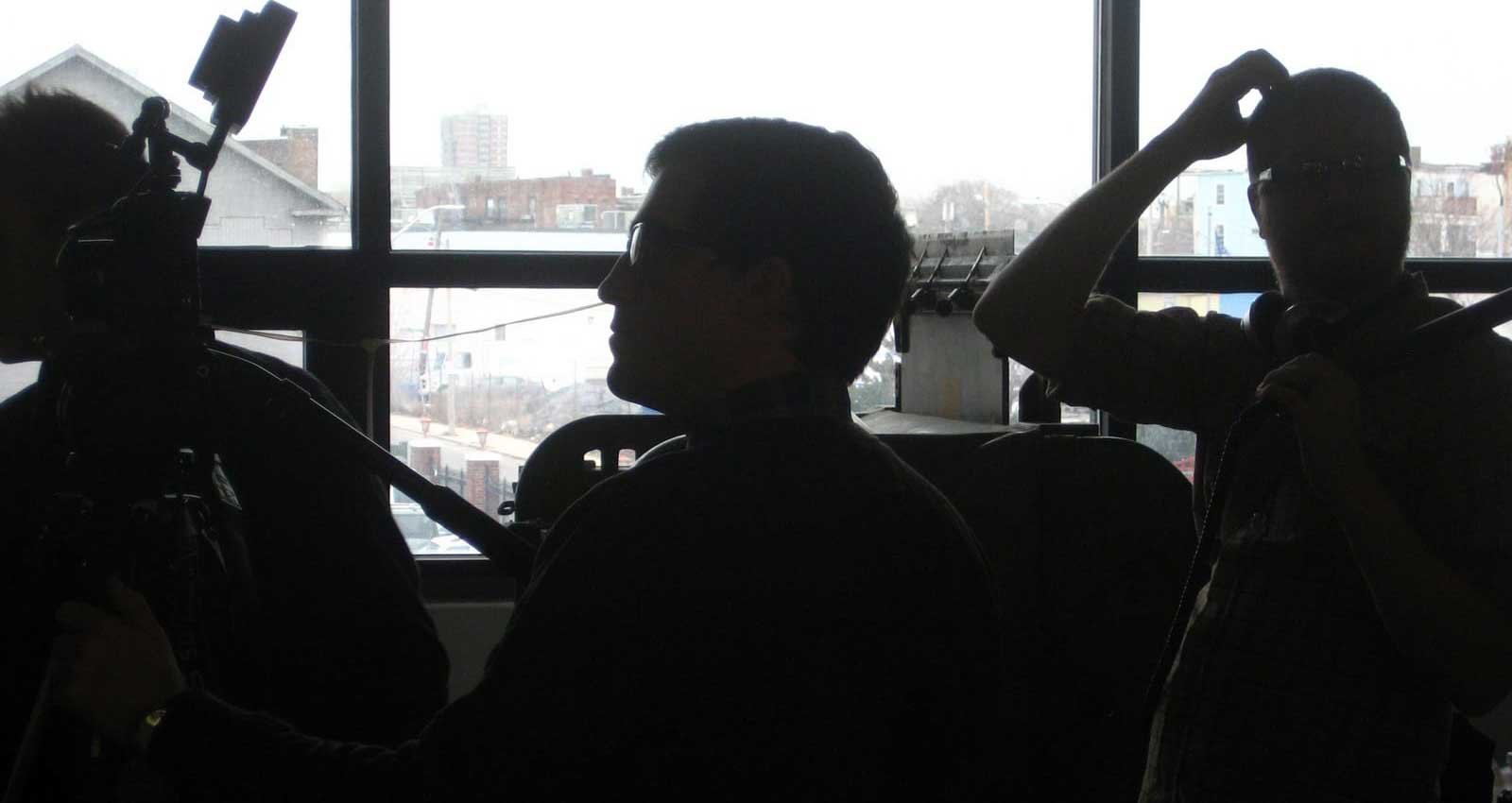February 24th, 2011 — The Boston Printing Plant Auction
Doug is walking in front of me with a stocky digital camera mounted on this frame kind of thing that sits on his shoulder when he’s shooting. He says the frame is so a little digital SLR that shoots beautiful high definition video can feel like the big, heavy, old-school video cameras it now replaces. He enjoys the irony.
He is not filming now and I am not recording sound. I am filling in because the two guys who make up the film crew with him, Jesse and Brandon, could not make this trip. I have slung over my shoulder this heavy, grey box that wears its own backpack and shows me a lot of lights, which I do my best to ignore. In my hand is a microphone that looks like one of those things that people direct airplanes with, but black and covered with a foam sleeve.
As we stop to see which lot the auctioneer is taking bids for, an older gentleman asks Doug what we’re up to. Doug explains that he is making a film about the Linotype machine, and we’re here to see what happens to the three Linotypes that are being auctioned off today.
The older gentleman shows no lack of enthusiasm in the subject and begins talking about friends who have worked in the newspaper industry, for The Boston Globe among others. We’ve already heard stories like this today and we will hear more before we’re done. Stories of men working their lives away at printing presses, becoming obsolete almost overnight as the processes of print succumb one by one to their cheaper, faster, easier digital counterparts.
And that’s what this project is all about for Doug. What happens to a history-changing machine that used to be at the heart of an entire industry? What happens to the people who have invested whole careers getting to know these giant, unintelligible machines inside and out? And what happens if a whole generation grows up not even knowing of their existence, let alone how they work?
Watching, Waiting
Doug is focused and doesn’t have much patience for old men’s stories right now. ‘I’m sorry,’ he says, ‘Can you excuse us? We need to go film this.’ I smile and follow him over to the crowd gathered around the auctioneer.
The next item is an old phone booth, made of wood and beautifully built. The real prize is inside though, hundreds of photos of scantily clad women taped to the walls of the booth. We’ve already met the fellow who is responsible for the photos. He used to work here at the City of Boston’s Graphic Arts Printing Plant. The collection took him years to assemble, he proudly tells anyone who will listen.
We’re not filming. Whenever someone old starts telling Doug stories, he says we have to go film something. It has happened a couple times already.
We taped for a while earlier. Now we’re just waiting for the Linotype machines to be auctioned. Doug flew in from Springfield, Missouri just to record it happening. He had never heard of an auction like this. An entire city getting rid of its whole printing department. Whole floors of paper, tools and equipment being auctioned off. It no longer makes financial sense for the city to keep it running. From now on, all print jobs for the city will be outsourced to private companies. They say it will save a million a year.
The Prize of the Auction
In the same area where the two healthier Linotype machines sit — and almost engulfing them — is the real prize of this auction for many who have come today. It is a massive amount of print equipment, enough to fill a room, all being sold together in one lot. There are cabinets and drawers full of metal typefaces of all sizes and kinds. Letterpress hobbyists go crazy over this stuff and they’re hoping to work out deals with whoever wins it. If they’re really lucky, the winner will be ready to resell stuff piecemeal on the spot.
Letterpress is Doug’s specialty. His thesis was setting up the old letterpress machine at Missouri State University along with all the necessary paraphernalia for operating it: the ink, the rollers, the typefaces, all organized in their cabinets and drawers. He’s interested to see what happens with the lot, and I can’t help but get caught up in the excitement too.
And that’s why the auctioning of the Linotypes, the whole reason we are there, totally catches us by surprise. We’re in the middle of the excitement of the big print lot, caught up in the drama as bidders drop out and it finally comes down to two.
They’re back and forth, working their way up to ten grand. One bidder backs down — he’s not willing to go that high.
Sold! To the highest bidder. And now the next lot, the first Linotype machine. Ohgeezhitrecordhitrecord!
Linotypes, Get ‘Em While They’re Hot
I hold the mic outstretched, like some sort of midget-sized fluffy lightsaber while Doug stands as tight up against the wall as he can to fit as much into the frame as possible.
The auctioneer starts at one hundred dollars. Nobody bids. Then this guy says ten dollars. The auctioneer says you’re killing me. Fine, ten dollars. Anyone else? Anyone else? Anyone else?
Nothing.
Okay, the auctioneer says to the lone bidder, but you have to take the other one too.
Twenty bucks and they’re both sold. I should mention the cost of getting them out of the building is somewhere around two grand each.
And that is it. We hang out and get an interview with the guy who is proud new owner of two Linotype machines, another with a metal scrapper, and another with the auctioneer. We miss the third Linotype getting auctioned off because we have to move Doug’s rental car, but we’re not completely sure they even tried to auction it.
When Doug is satisfied we have gotten everything we can, we walk down the street and pick up some cannoli (you can’t go to Boston’s North End and not get cannoli) and head home. Another day in the life of a niche-documentary filmmaker.
March 10th, 2011 — A Morning at Firefly Press
The second time I got to be part of the behind-the-scenes of Linotype: The Film was when Doug came back to Boston with Brandon and Jesse, the rest of the crew, to meet with and film the men behind Firefly Press, John and Jesse, who operate their own functioning Linotype machine and were happy to talk about it for the documentary.
I took some photos while the crew filmed interviews of both John and Jesse, as well as footage of the Linotype in action, and some more footage of one the Linotype’s biggest competitors, the Monotype. Doug told me later that there are only two people he found under the age of, I think 40, in the entire country who know how to operate a Linotype machine, and Jesse is one of the two.
We ate lunch at a vegan restaurant and Jesse of Firefly told me to come back any time and check out the studio, something I have yet to take him up on.
February 13th, 2012 — The Boston Premiere
My third experience with the making of the film was not nearly as behind-the-scenes as the other two. Doug and Brandon were coming to Boston to premiere it (not the world premiere — that was in New York, of course) at the Paramount Theatre in Boston’s Theater District, and they invited me to come along. How could I say no? I was excited to go and finally see the result of all their hard work. We showed up early and Doug and Brandon, both dressed to the nines, set up tables and laid out t-shirts, pins, and DVD order forms.
The premiere was in a nice little film-screening theater with maybe 50 or 70 people in attendance. The film was funnier than I expected, more about the crazy, passionate people who love this otherwise forgotten machine than about the machine itself. During the question and answer time that followed, Doug said it was Brandon who convinced him to make the movie more about the quirky characters and less about the machine. Quite a few of those characters were on the Q&A panel, including John and Jesse from Firefly and the guy who bought the two Linotypes at the auction.
Afterwards, we went and ate sushi at a tiny, little sushi bar behind a cell phone vendor (you can’t go to Chinatown without checking Yelp to find the best, most random, hidden little sushi place in town).
That’s the story of the making of Linotype: The Film as I experienced it. One of my dreams is to someday be involved in the making of a full-length feature film from start to finish. Until that happens, I’ll have my brief brush with film-making and all the accompanying fame and fortune it brings thanks to Doug, Jesse, and Brandon and a little charmer of a film about an obsolete printing machine and the people who still love it.

